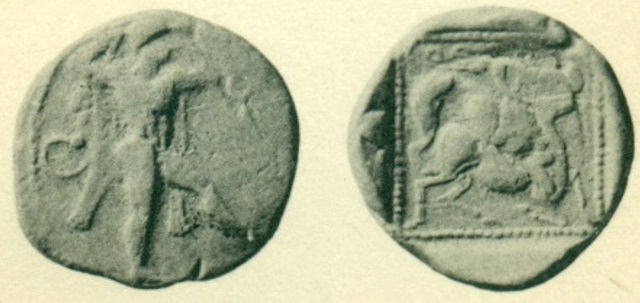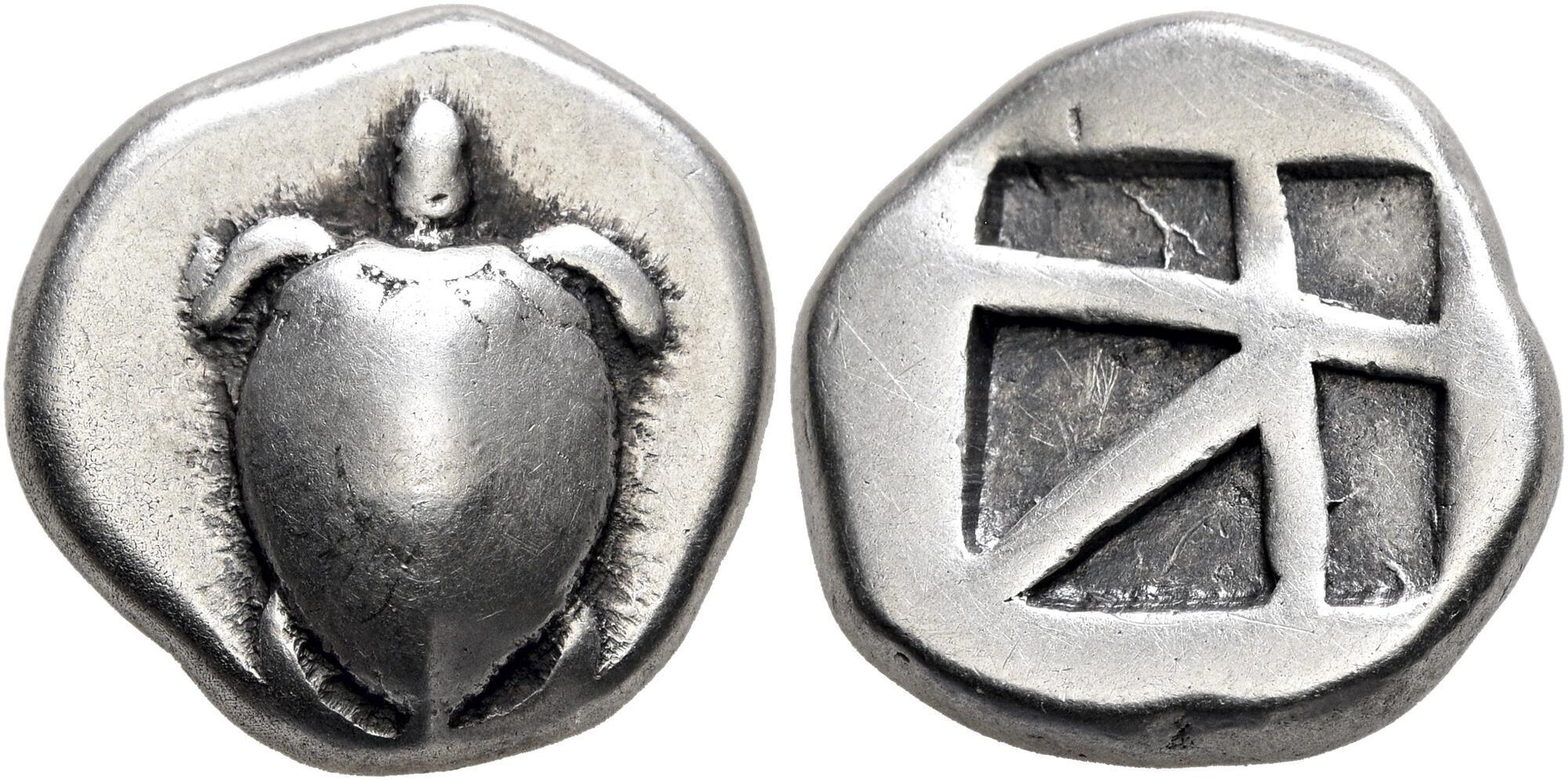400 BCE - 392 BCE | LMLKB (Aramaic)
Overstriking coin
Citium_over_Aegina_Athens, _Petsalis.jpg
Description
| ObverseInscription or printing placed on the obverse.:
|
Herakles in fighting stance to right, wearing lion skin, holding club overhead in right hand and bow extended before him in left hand.
|
ReverseInscription or printing placed on the reverse.:
|
LMLKB (Aramaic) (Aramaic) Lion attacking stag crouching right within dotted incuse square.
|
Mint and issuing power
Chronology
| FromIdentifies the initial date in a range assigned in a numismatic context. 400 BCE toIdentifies the final date in a range assigned in a numismatic context.. 392 BCE
|
Classical 480-323 BC  periodTime period of the numismatic object. periodTime period of the numismatic object.
|
Physical description
MetalThe physical material (usually metal) from which an object is made.: Silver 
|
WeightWeight of the numismatic object (in grams). in grams: 11.0111.01 g <br />11,010 mg <br />
|
DenominationTerm indicating the value of a numismatic object. Examples: tetradrachm, chalkous, denarius.: double siglos 
|
|
|
|
StandardStandard.: Aeginetic
|
References
| Coin referenceReference of the Coin:
|
Seltman 1924b, n° 10, p. 6-7, pl. 3.
|
Coin series referenceReference to coin series study:
|
BMC Cyprus1BMC Cyprus, London, n° 71, Seltman 1924b2Seltman 1924b, n° 10, p. 6-7, pl. 3, Tziambazis 20023Tziambazis 2002, 28, Zapiti - Michaelidou 20084Zapiti - Michaelidou 2008
|
Description
| ObverseInscription or printing placed on the obverse.:
|
Turtle.
|
ReverseInscription or printing placed on the reverse.:
|
Incuse square.
|
Mint and issuing power
| MintIdentifies the place of manufacture or issue of a numismatic object. ᵖ:
|
Aegina
|
Ancient regionAncient region. ᵖ
|
Aegina
|
Modern countryModern country: Greece
|
AuthorityIdentifies the authority in whose name (explicitly or implicitly) a numismatic object was issued. ᵖ:
|
|
Chronology
| FromIdentifies the initial date in a range assigned in a numismatic context. 480 BCE toIdentifies the final date in a range assigned in a numismatic context.. 457 BCE
|
Classical 480-323 BC  periodTime period of the numismatic object. periodTime period of the numismatic object.
|
Physical description
| DenominationTerm indicating the value of a numismatic object. Examples: tetradrachm, chalkous, denarius. ᵖ:
|
stater 
|
StandardStandard. ᵖ:
|
Aeginetic
|
References
References
- ^ Hill, George Francis (1904), A Catalogue of the Greek coins in the British Museum, vol XX : Cyprus, London, cxliv, 119 p., xxvi pl.,
- ^ Seltman, Charles T. (1924), A Hoard from Side, NNM 22, New York
- ^ Tziambazis, Elias (2002), A catalogue of the coins of Cyprus: from 560 B.C. to 1571 A.D., Larnaca, 89 p.
- ^ Zapiti, Eleni - Michaelidou, Lefki (2008), Coins of Cyprus : from the collection of the Bank of Cyprus Cultural Foundation, Nicosia, Bank of Cyprus Cultural Foundation, 329 p.
- ^ Hoover, Oliver D. (2010), The Handbook of Greek Coinage Series, volume 6 : handbook of coins of the islands: Adriatic, Iionian, Thracian, Aegean, and Carpathian seas (excluding Crete and Cyprus), sixth to first centuries BC, Lancaster, 358 p.
- ^ Meadows, Andrew (forthcoming), Greek coinage in the Persian Empire: The Malayer 1934 Hoard (IGCH 1790).


